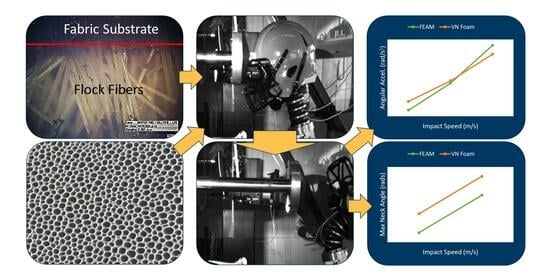Novel Fiber-Based Padding Materials for Football Helmets
Abstract
:1. Introduction
2. Experimental Methods and Design
2.1. Fabrication of Padding Materials
2.2. Experimental Setup
2.3. Experimental Design
- As Purchased (with inflatable bladder)
- VN Foam (no inflatable bladder)
- FEAM0610 (6 denier, 1 mm fiber length)
- FEAM6030 (60 denier, 3 mm fiber length)
- FF0610 (Same as FEAM0610 but with 3 mm thick VN foam substrates)
- FF6030 (Same as FEAM6030 but with 3 mm thick VN foam substrates)
3. Experimental Results
3.1. Considerations of Inflatable Bladder
3.2. Low Impact Velocity
3.3. Medium Impact Velocity
3.4. High Impact Velocity
3.5. High Speed Video Neck Flexion Analysis
4. Discussion
5. Conclusions
Author Contributions
Funding
Data Availability Statement
Conflicts of Interest
References
- Ford, J.H.; Giovanello, K.S.; Guskiewicz, K.M. Episodic memory in former professional football players with a history of concussion: An event-related functional neuroimaging study. J. Neurotrauma. 2013, 30, 1683–1701. [Google Scholar] [CrossRef] [PubMed]
- Jordan, B.D. The clinical spectrum of sport-related traumatic brain injury. Nat. Rev. Neurol. 2013, 9, 222–230. [Google Scholar] [CrossRef] [PubMed]
- Hampshire, A.; MacDonald, A.; Owen, A.M. Hypoconnectivity and hyperfrontality in retired American football players. Sci. Rep. 2013, 3, 2972. [Google Scholar] [CrossRef] [PubMed]
- Didehbani, N.; Munro Cullum, C.; Mansinghani, S.; Conover, H.; Hart, J., Jr. Depressive symptoms and concussions in aging retired NFL players. Arch. Clin. Neuropsychol. 2013, 28, 418–424. [Google Scholar] [CrossRef] [PubMed]
- Kumar, N.S.; Chin, M.; O’Neill, C.; Jokoi, A.M.; Tabb, L.; Wolf, M. On-field performance of national football league players after return from concussion. Am. J. Sports Med. 2014, 42, 2050–2055. [Google Scholar] [CrossRef] [PubMed]
- Clay, M.B.; Glover, K.L.; Lowe, D.T. Epidemiology of concussion in sport: A literature review. J. Chiropr. Med. 2013, 12, 230–251. [Google Scholar] [CrossRef] [PubMed]
- McGuine, T.A.; Hetzel, S.; McCrea, M.; Brooks, M.A. Protective equipment and player characteristics associated with the incidence of sport-related concussion in high school football players: A multifactorial prospective study. Am. J. Sports Med. 2014, 42, 2470–2478. [Google Scholar] [CrossRef] [PubMed]
- Stein, C.J.; MacDougall, R.; Quatman-Yates, C.C.; Myer, G.D.; Sugimoto, D.; Dennison, R.J.; Meehan, W.P. Young athletes’ concerns about sport-related concussion: The patient’s perspective. Clin. J. Sport Med. 2016, 26, 386–390. [Google Scholar] [CrossRef]
- Schneider, D.K.; Grandhi, R.K.; Bansal, P.; Kuntz, G.E.; Webster, K.E.; Logan, K.; Barber, K.D.F.; Myer, G.D. Current state of concussion prevention strategies: A systematic review and meta-analysis of prospective, controlled studies. Br. J. Sports Med. 2017, 51, 1473–1482. [Google Scholar] [CrossRef]
- Cecchi, N.J.; Oros, T.J.; Ringhofer, J.J.; Monroe, D.C. Comparison of head impact attenuation capabilities between a standard American football helmet and novel protective equipment that couples a helmet and shoulder pads. Sports Eng. 2019, 22, 16. [Google Scholar] [CrossRef]
- Johnston, J.M.; Ning, H.; Kim, J.-E.; Kim, Y.-H.; Soni, B.; Reynolds, R.; Cooper, L.; Andrews, J.B.; Vaidya, U. Simulation, fabrication and impact testing of a novel football helmet padding system that decreases rotational acceleration. Sports Eng. 2015, 18, 11–20. [Google Scholar] [CrossRef]
- McElhaney, J.H.; Roberts, V.L.; Hilyard, J.F. Properties of human tissues and components: Nervous tissues. In Handbook of Human Tolerance; Automobile Research Institute Inc.: Tokyo, Japan, 1976; Volume 143. [Google Scholar]
- Gennarelli, T.A.; Thibault, L.E.; Ommaya, A.K. Pathophysiological Responses to Rotational and Translational Accelerations of the Head. In Proceedings of the 16th Stapp Car Crash Conference, Detroit, MI, USA, 8–10 November 1972; Society of Automotive Engineers: Warrendale, PA, USA, 1972. [Google Scholar]
- Gennarelli, T.A.; Thibault, L.E.; Tomei, G.; Wiser, T.G.; Adams, G.J. Directional Dependence of Axonal Brain Injury due to Centroidal and Non-Centroidal Acceleration. In Proceedings of the 31st Stapp Car Crash Conference, New Orleans, LA, USA, 9–11 November 1987; SAE Technical Paper. p. 872197. [Google Scholar]
- Sances, A., Jr.; Herbst, B.; Khadilkar, A.V. Biomechanical Analysis of Padding. In Proceedings of the ASME International Mechanical Engineering Congress and Exposition, Nashville, TN, USA, 14–19 November 1999. [Google Scholar]
- Gambel, G.M.; Hoshizaki, T.B. Compressive properties of helmet materials subjected to dynamic impact loading of various energies. Eur. J. Sport. Sci. 2008, 8, 341–349. [Google Scholar] [CrossRef]
- Ramirez, B.J.; Gupta, V. Evaluation of novel temperature-stable viscoelastic polyurea foams as helmet liner materials. Mater. Des. 2018, 137, 298–304. [Google Scholar] [CrossRef]
- Foster, L.; Peketi, P.; Allen, T.; Senior, T.; Duncan, O.; Alderson, A. Application of Auxetic Foam in Sports Helmets. Appl. Sci. 2018, 8, 354. [Google Scholar] [CrossRef]
- Vicis, Inc. 2019. Available online: https://vicis.com/products/zero1 (accessed on 3 December 2019).
- Hanna, B.; Adams, R.; Townsend, S.; Robinson, M.; Soe, S.; Stewart, M.; Burek, R.; Theobald, P. Auxetic metamaterial optimisation for head impact mitigation in American football. Int. J. Impact Eng. 2021, 157, 103991. [Google Scholar] [CrossRef]
- Sokoloff, J.B. Hydrophilic porous materials as helmet padding able to prevent traumatic brain injuries. J. Appl. Phys. 2022, 132, 125102. [Google Scholar] [CrossRef]
- Decker, W.; Baker, A.; Ye, X.; Brown, P.; Stitzel, J.; Gayzik, F.S. Development and Multi-Scale Validation of a Finite Element Football Helmet Model. Ann. Biomed. Eng. 2020, 48, 258–270. [Google Scholar] [CrossRef] [PubMed]
- Mills, S.T.; Young, T.S.; Chatham, L.S.; Poddar, S.; Carpenter, R.D.; Yakacki, C.M. Effect of foam densification and impact velocity on the performance of a football helmet using computational modeling. Comput. Methods Biomech. Biomed. Eng. 2021, 24, 21–32. [Google Scholar] [CrossRef]
- Cecchi, N.J.; Alizadeh, H.V.; Liu, Y.; Camarillo, D.B. Finite element evaluation of an American football helmet featuring liquid shock absorbers for protecting against concussive and subconcussive head impacts. Front. Bioeng. Biotechnol. 2023, 11, 1160387. [Google Scholar] [CrossRef]
- Lewis, A.; Matos, H.; Rice, J.; Kim, Y. Impact force loss behavior of flocked surfaces. Text. Res. J. 2016, 88, 392–412. [Google Scholar] [CrossRef]
- Fodor, K.; Chalivendra, V.; Kim, Y.; Lewis, A. Dynamic Mechanical Behavior of Flocked Layer Composite Materials. Compos. Struct. 2018, 207, 677–683. [Google Scholar] [CrossRef]
- Kim, Y.K.; Chalivendra, V.B.; Lewis, A.F.; Fasel, B. Designing flocked energy-absorbing material layers into sport and military helmet pads. Text. Res. J. 2022, 92, 15–16. [Google Scholar] [CrossRef]
- Correia, J.; Chalivendra, V.; Kim, Y. Parametric study of a fibrous energy absorbing material under impact shear loading. Compos. Struct. 2020, 232, 111583. [Google Scholar] [CrossRef]
- Rowson, S.; Duma, S.M.; Beckwith, J.G.; Chu, J.J.; Greenwald, R.M.; Crisco, J.J.; Brolinson, G.P.; Duhaime, A.-C.; McAllister, T.W.; Maerlender, A.C. Rotational head kinematics in football impacts: An injury risk function for concussion. Ann. Biomed. Eng. 2012, 40, 1–13. [Google Scholar] [CrossRef]
- Zhang, L.; Yang, K.H.; King, A.I. A Proposed Injury Threshold for Mild Traumatic Brain Injury. J. Biomech. Eng. 2004, 126, 226. [Google Scholar] [CrossRef] [PubMed]
- Kimpara, H.; Iwamoto, M. Mild traumatic brain injury predictors based on angular accelerations during impacts. Ann. Biomed. Eng. 2012, 40, 114–126. [Google Scholar] [CrossRef] [PubMed]
- Kleiven, S. Evaluation of head injury criteria using a finite element model validated against experiments on localized brain motion, intracerebral acceleration, and intracranial pressure. Int. J. Crashworthiness 2006, 11, 65–79. [Google Scholar] [CrossRef]
- Morrison, B.; Sundstrom, L.E.; Ateshian, G.A.; Thomas, F.C.; Cater, H.L.; Hung, C.T.; Ateshian, G.A.; Sundstrom, L.E. A Tissue Level Tolerance Criterion for Living Brain Developed with an In Vitro Model of Traumatic Mechanical Loading. SAE Tech. Pap. Ser. 2018, 1, 93–105. [Google Scholar]
- Elkin, B.S.; Morrison, B. Region-specific tolerance criteria for the living brain. Stapp. Car. Crash. J. 2007, 51, 127–138. [Google Scholar]
- NOCSAE. Standard Pneumatic Ram Test Method and Equipment Used in Evaluating the Performance Characteristics of Protective Headgear and Face Guards; NOCSAE: Litchfield Park, AZ, USA, 2015; pp. 1–9. [Google Scholar]
- Rowson, B.; Rowson, S.; Duma, S.M. Hockey STAR: A Methodology for Assessing the Biomechanical Performance of Hockey Helmets. Ann. Biomed. Eng. 2015, 43, 2429–2443. [Google Scholar] [CrossRef]
- Pellman, E.J.; Viano, D.C.; Tucker, A.M.; Casson, I.R.; Waeckerle, J.F. Concussion in Professional Football: Reconstruction of Game Impacts and Injuries. Neurosurgery 2003, 53, 799–814. [Google Scholar] [CrossRef] [PubMed]
- Pellman, E.J.; Viano, D.C.; Tucker, A.M.; Casson, I.R. Concussion in Professional Football: Location and Direction of Helmet Impacts—Part 2. Neurosurgery 2003, 53, 1328–1341. [Google Scholar] [CrossRef] [PubMed]
- Pellman, E.J.; Viano, D.C.; Withnall, C.; Shewchenko, N.; Bir, C.A.; Halstead, P.D. Concussion in professional football: Helmet testing to assess impact performance—Part 11. Neurosurgery 2006, 58, 78–95. [Google Scholar] [CrossRef] [PubMed]
- Jadischke, R. Football Helmet Fitment and its Effects on Helmet Performance. Master’s Thesis, Wayne State University, Detroit, MI, USA, 2012. [Google Scholar]
- Daly, C.A.; Payne, S.H.; Seiler, J.G. Severe Brachial Plexus Injuries in American Football. Orthopedics. 2016, 39, e1188–e1192. [Google Scholar] [CrossRef] [PubMed]
- Hrysomallis, C. Neck Muscular Strength, Training, Performance and Sport Injury Risk: A Review. Sports Med. 2016, 46, 1111–1124. [Google Scholar] [CrossRef]
- Bailey, A.; Funk, J.; Lessley, D.; Sherwood, C.; Crandall, J.; Neale, W.; Rose, N. Validation of a videogrammetry technique for analysing American football helmet kinematics. Sports Biomech. 2020, 19, 678–700. [Google Scholar] [CrossRef] [PubMed]
- Bailey, A.M.; Sherwood, C.P.; Funk, J.R.; Crandall, J.R.; Carter, N.; Hessel, D.; Beier, S.; Neale, W. Characterization of Concussive Events in Professional American Football Using Videogrammetry. Ann. Biomed. Eng. 2020, 48, 2678–2690. [Google Scholar] [CrossRef] [PubMed]
- Camarillo, D.B.; Shull, P.B.; Mattson, J.; Shultz, R.; Garza, D. An Instrumented Mouthguard for Measuring Linear and Angular Head Impact Kinematics in American Football. Ann. Biomed. Eng. 2013, 41, 1939–1949. [Google Scholar] [CrossRef]
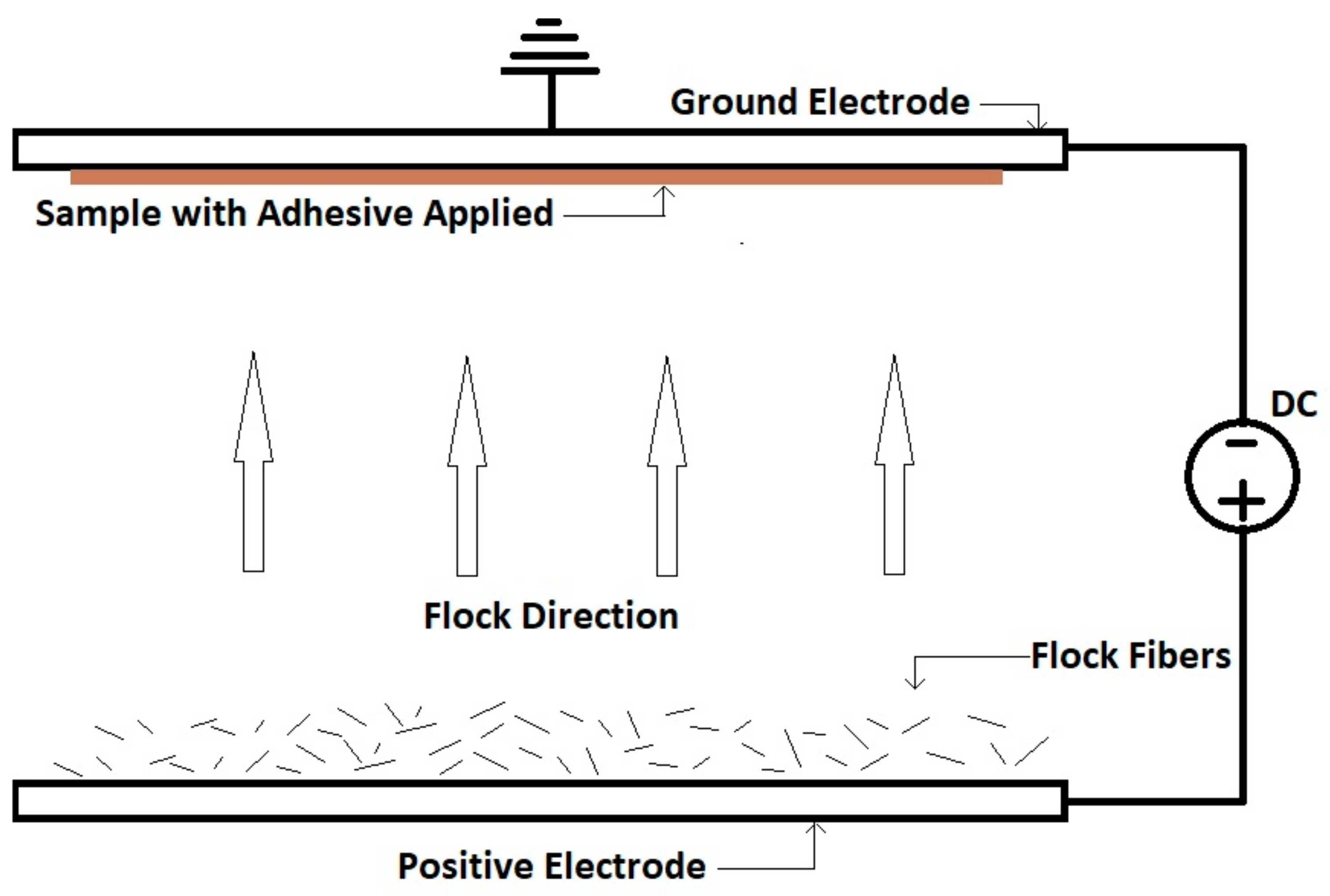

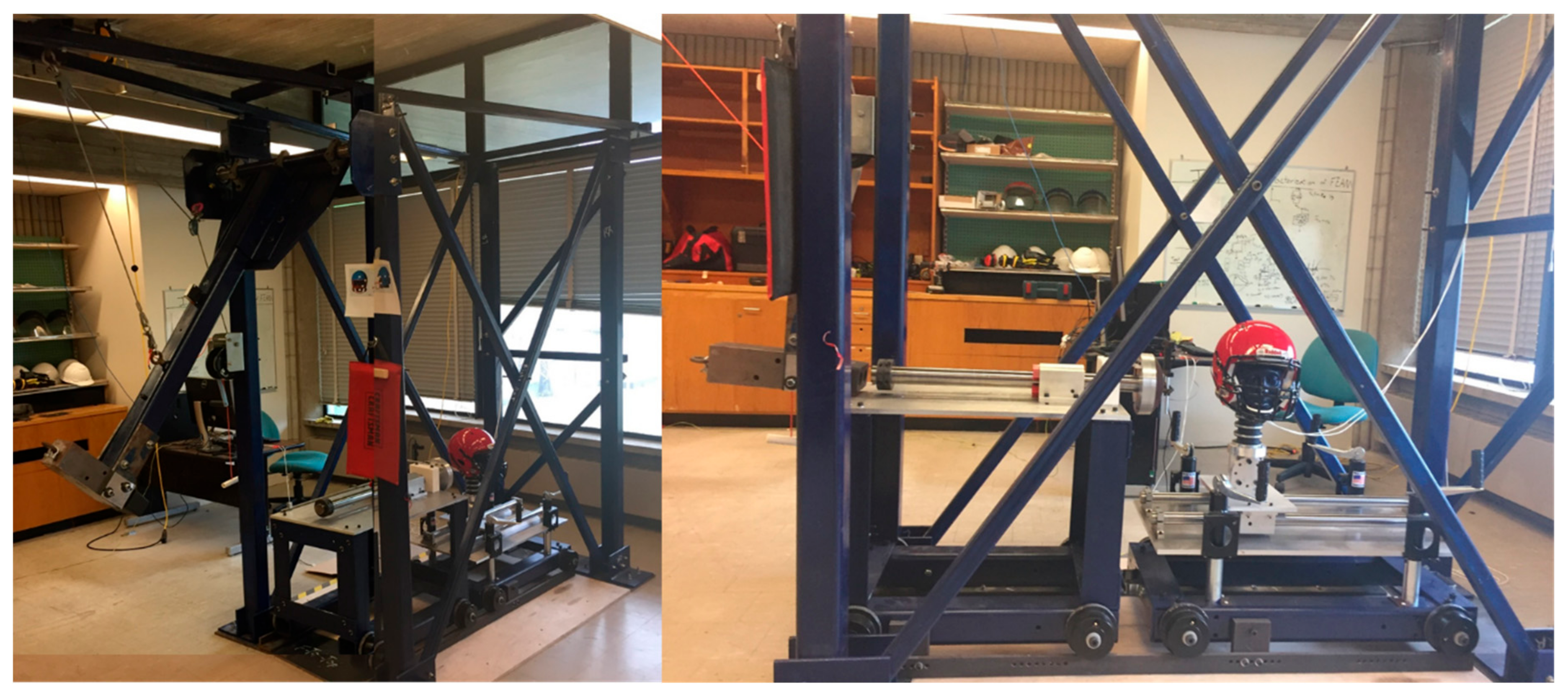
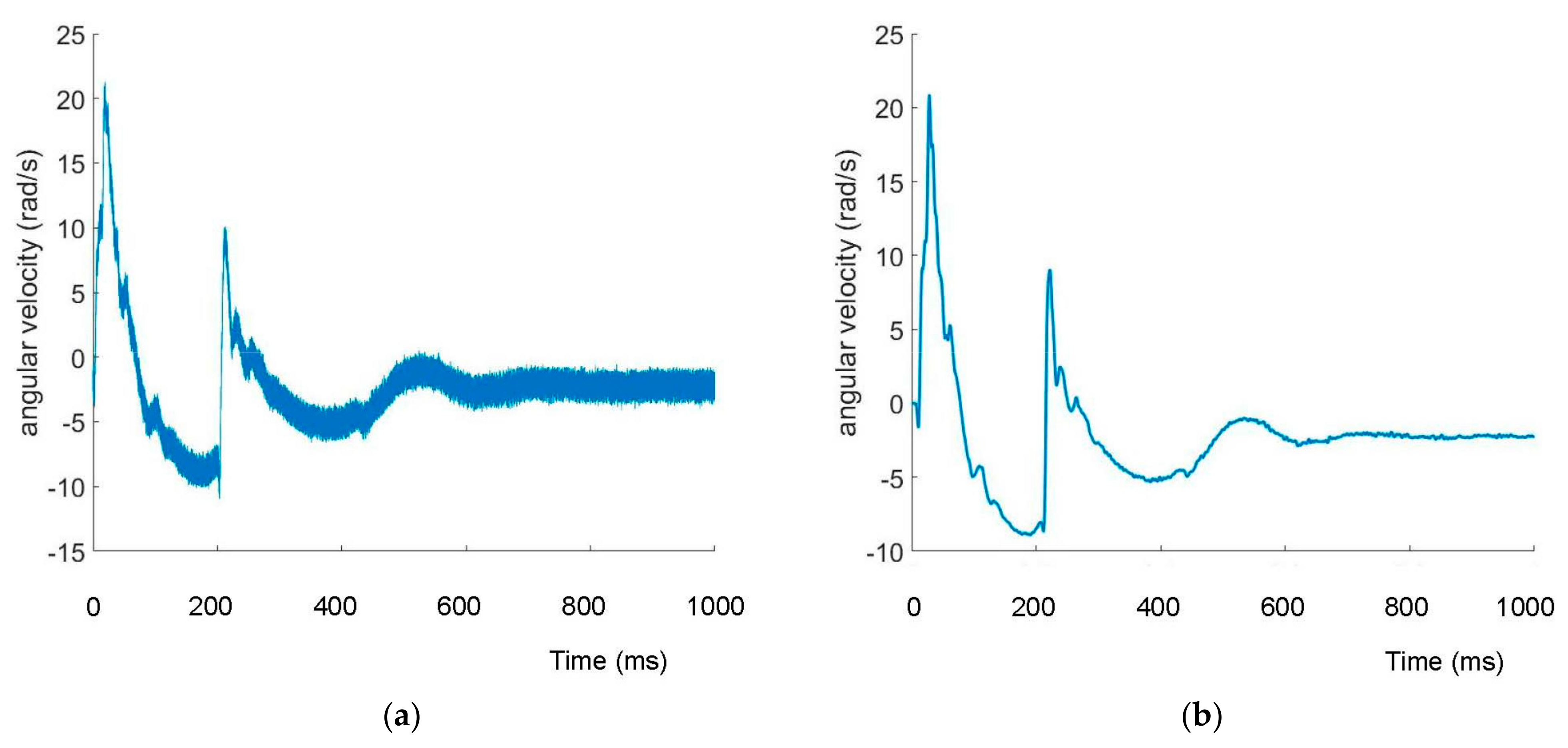
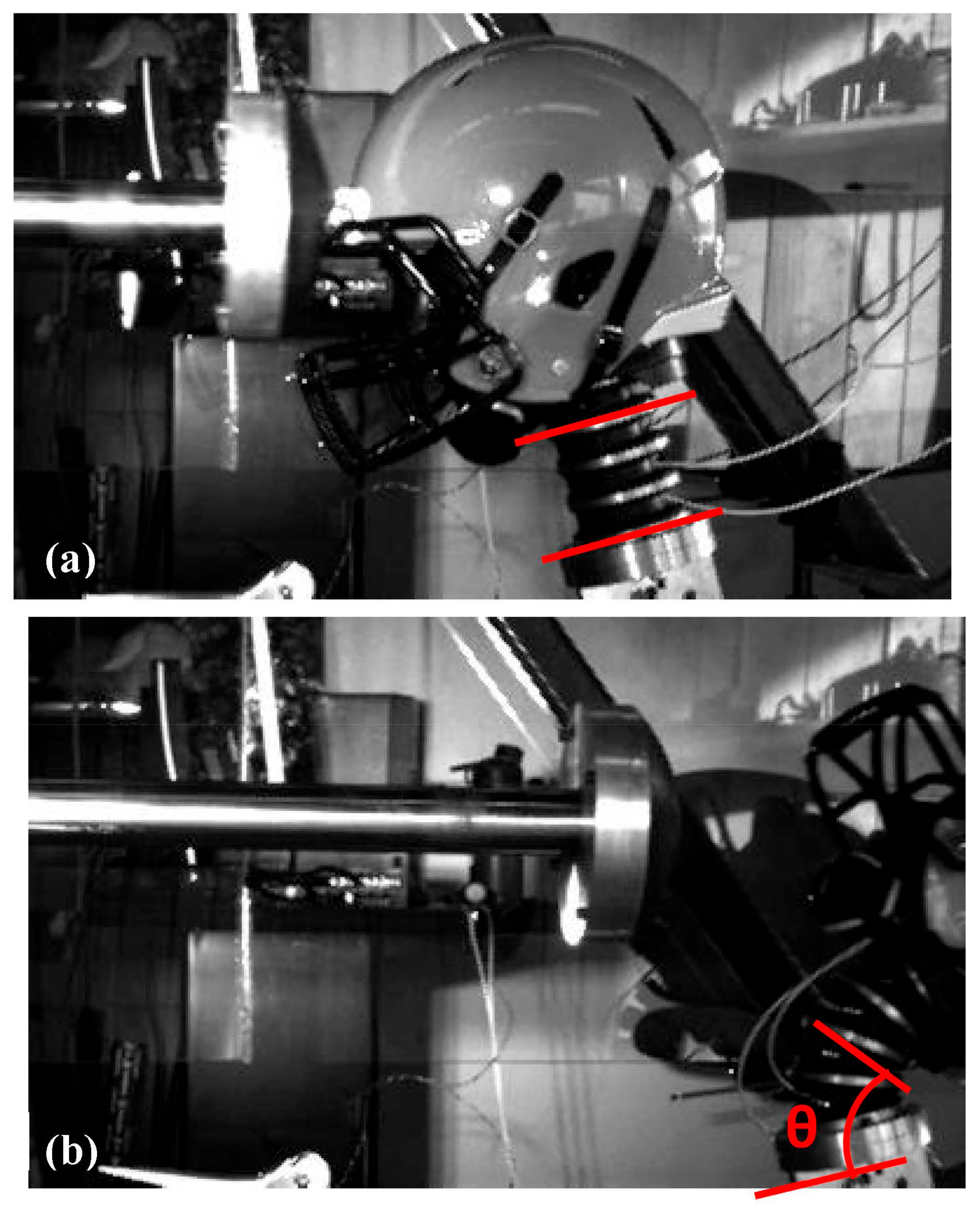
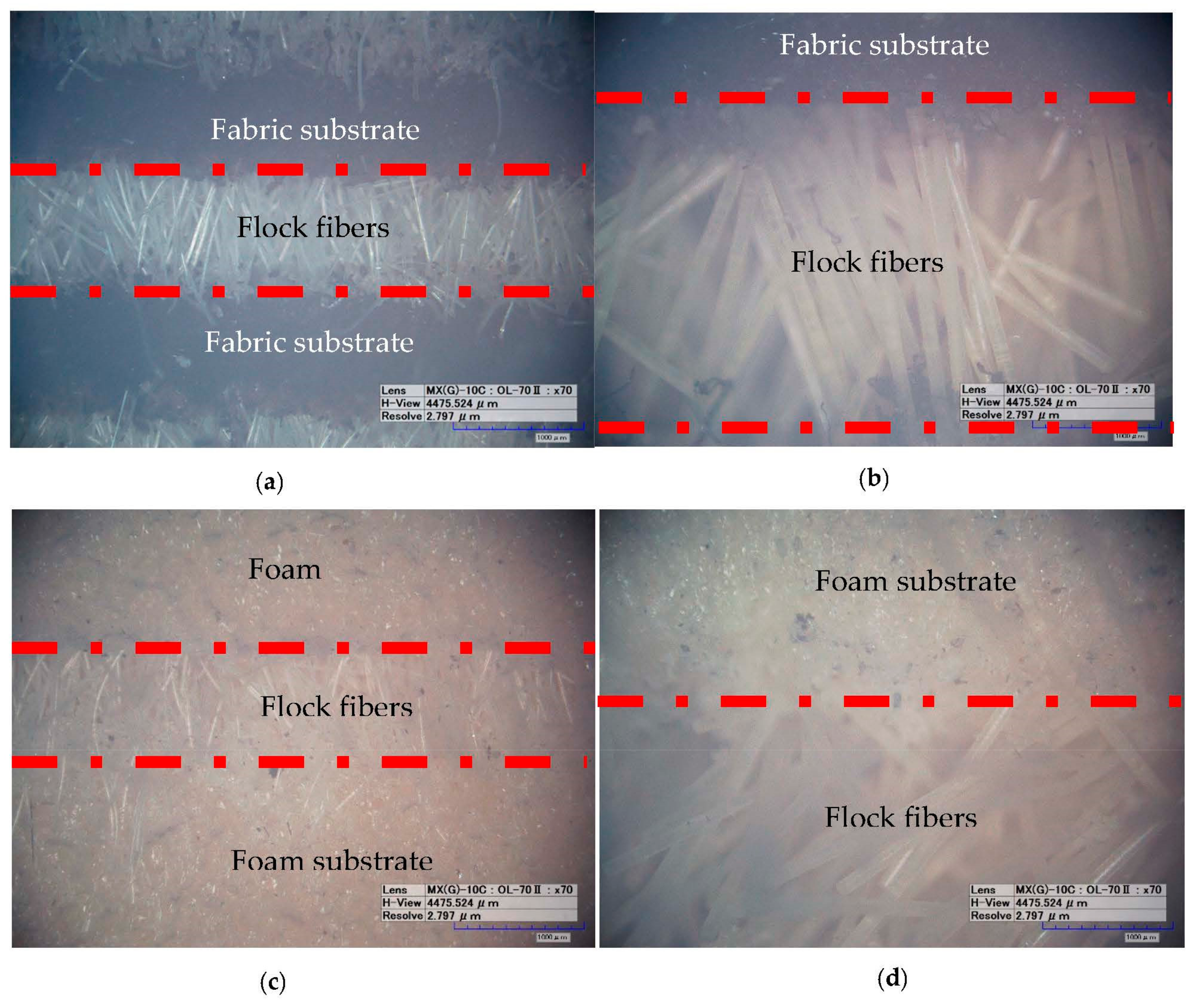
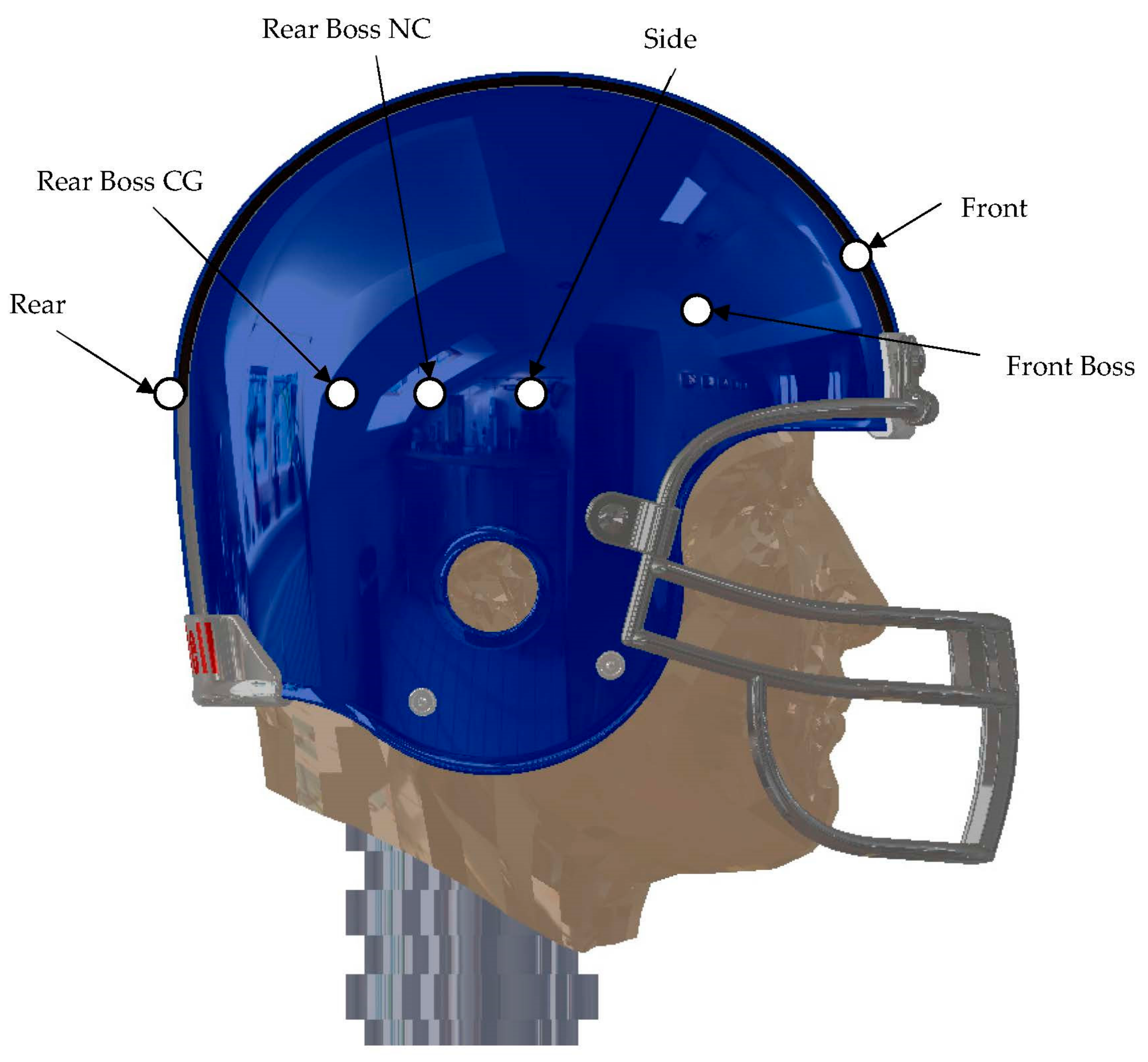
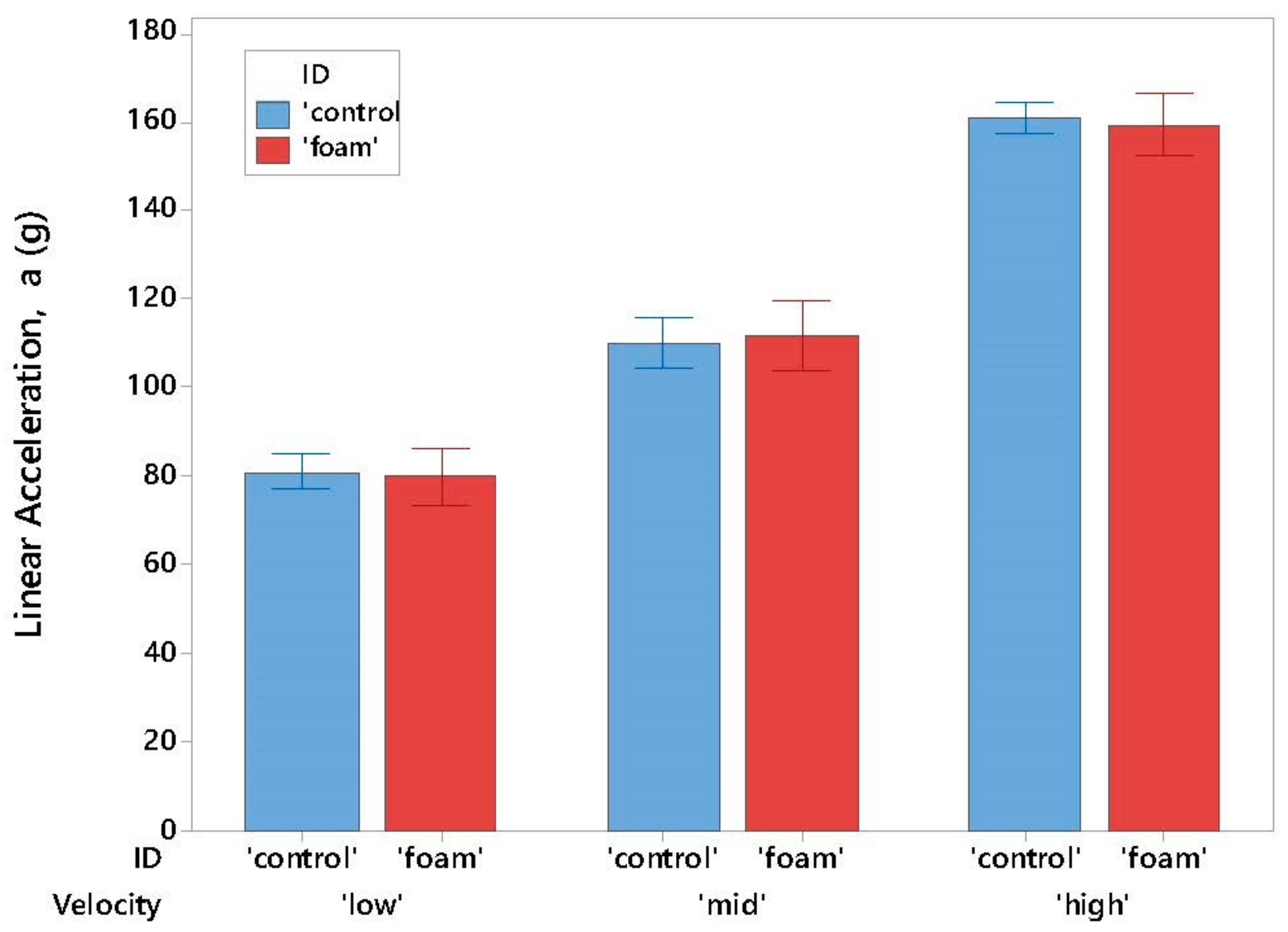

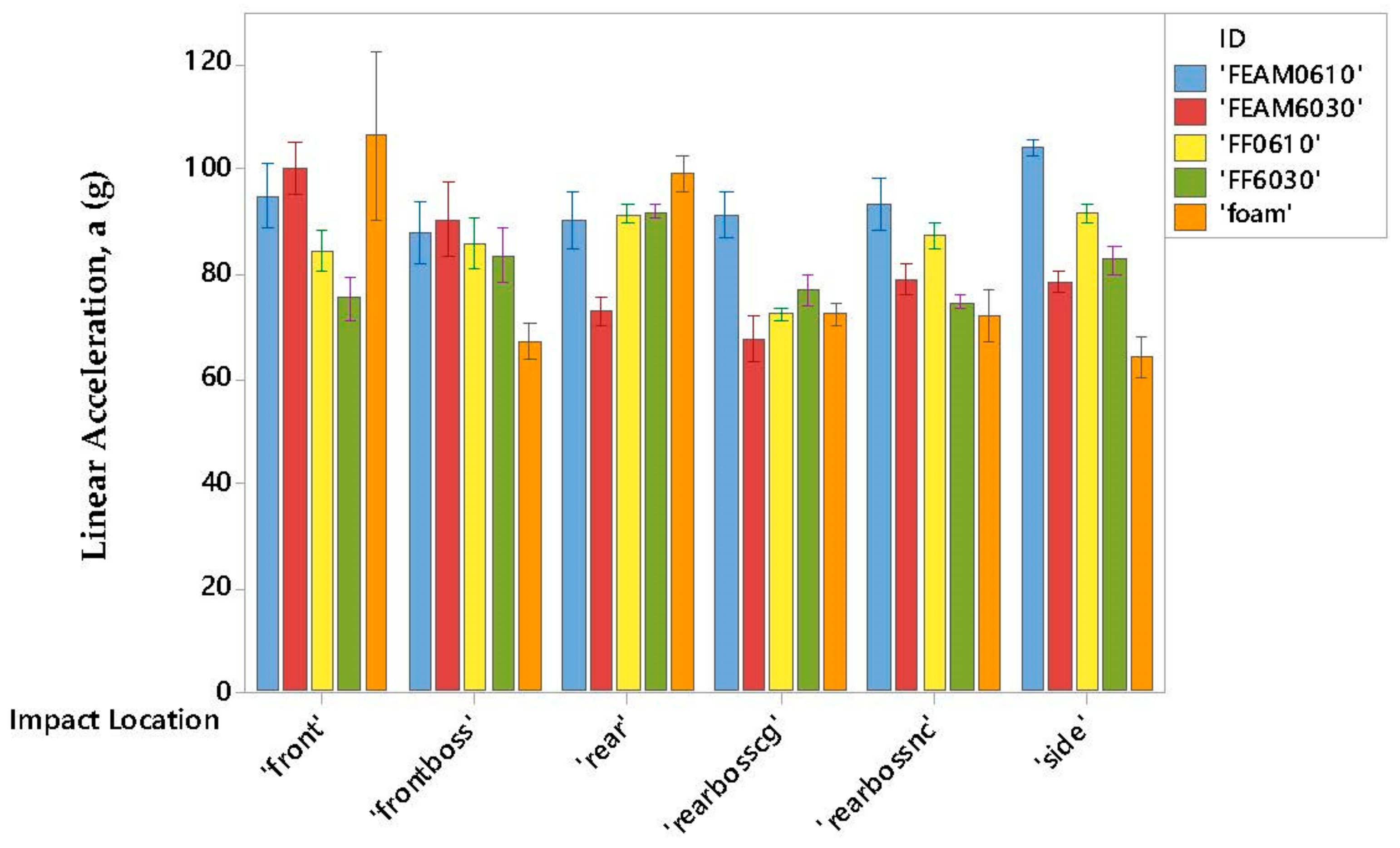
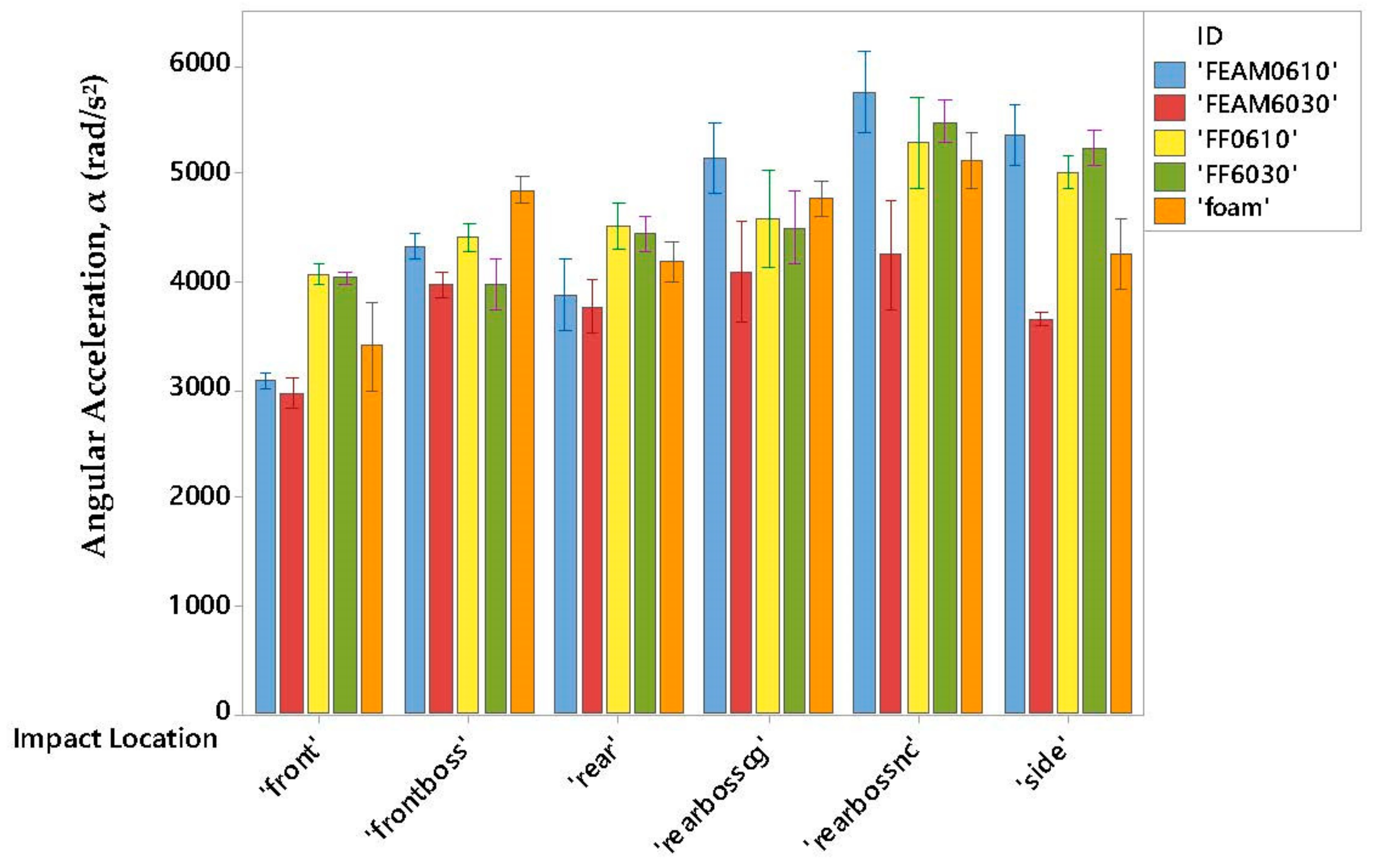

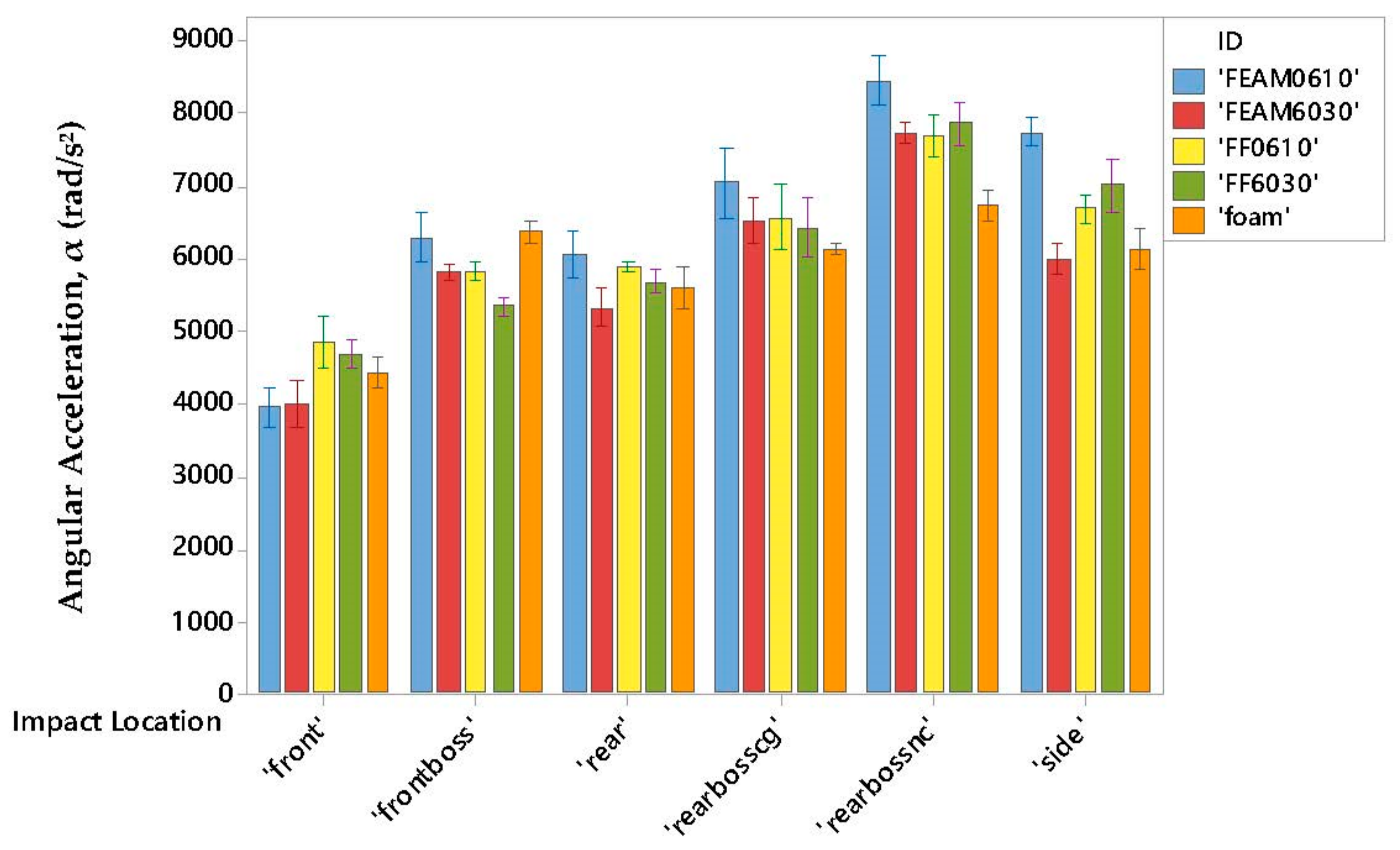
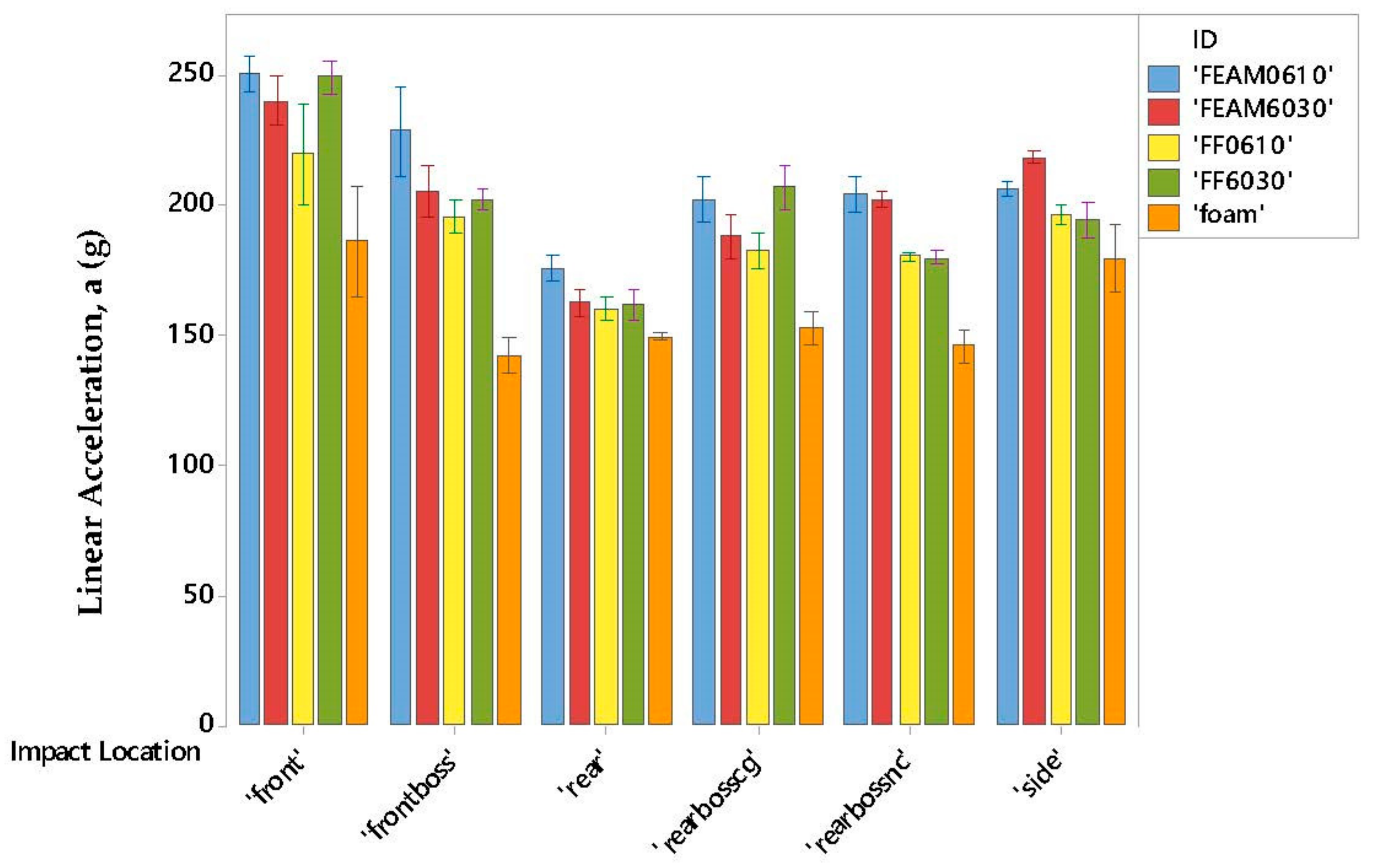
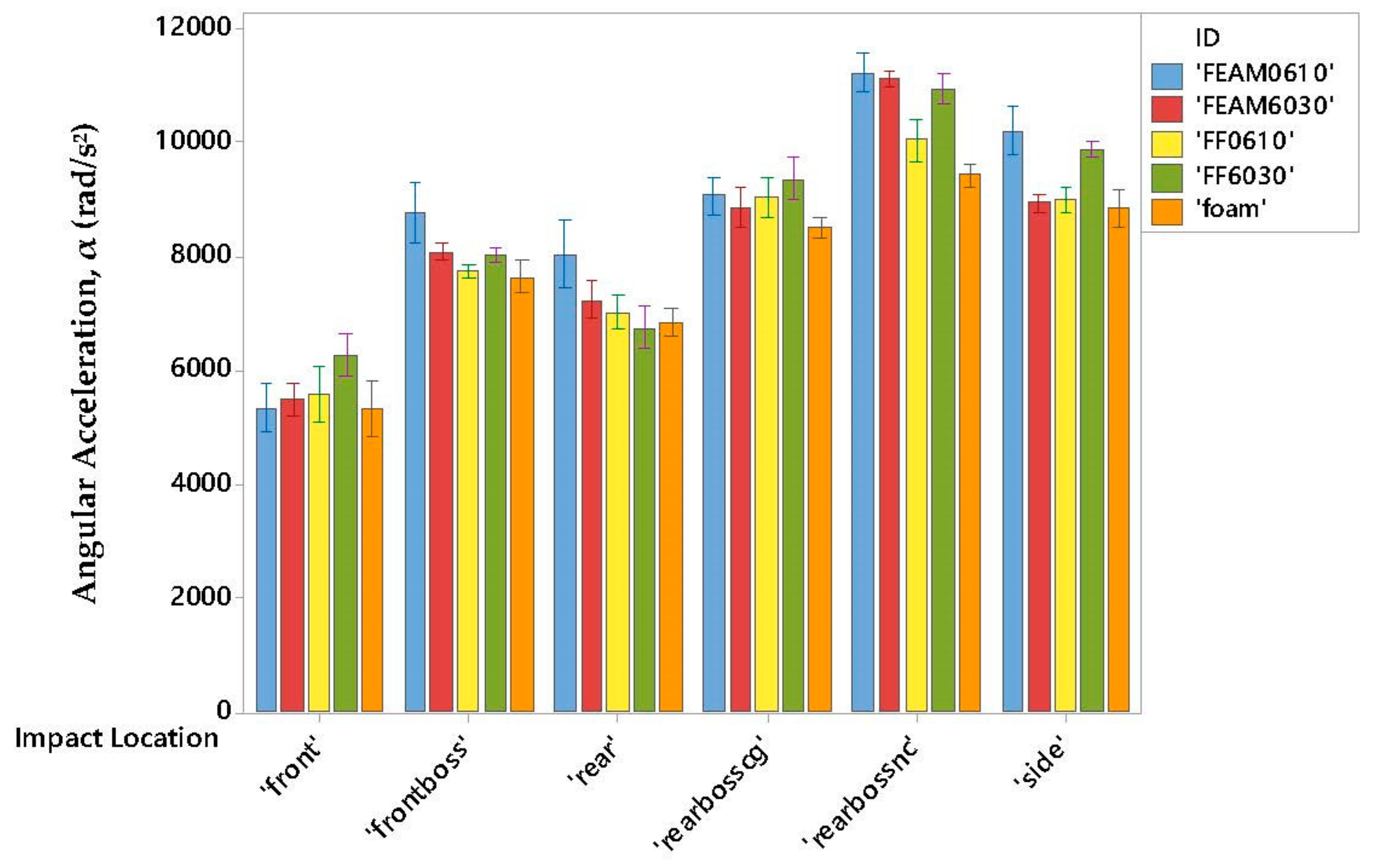

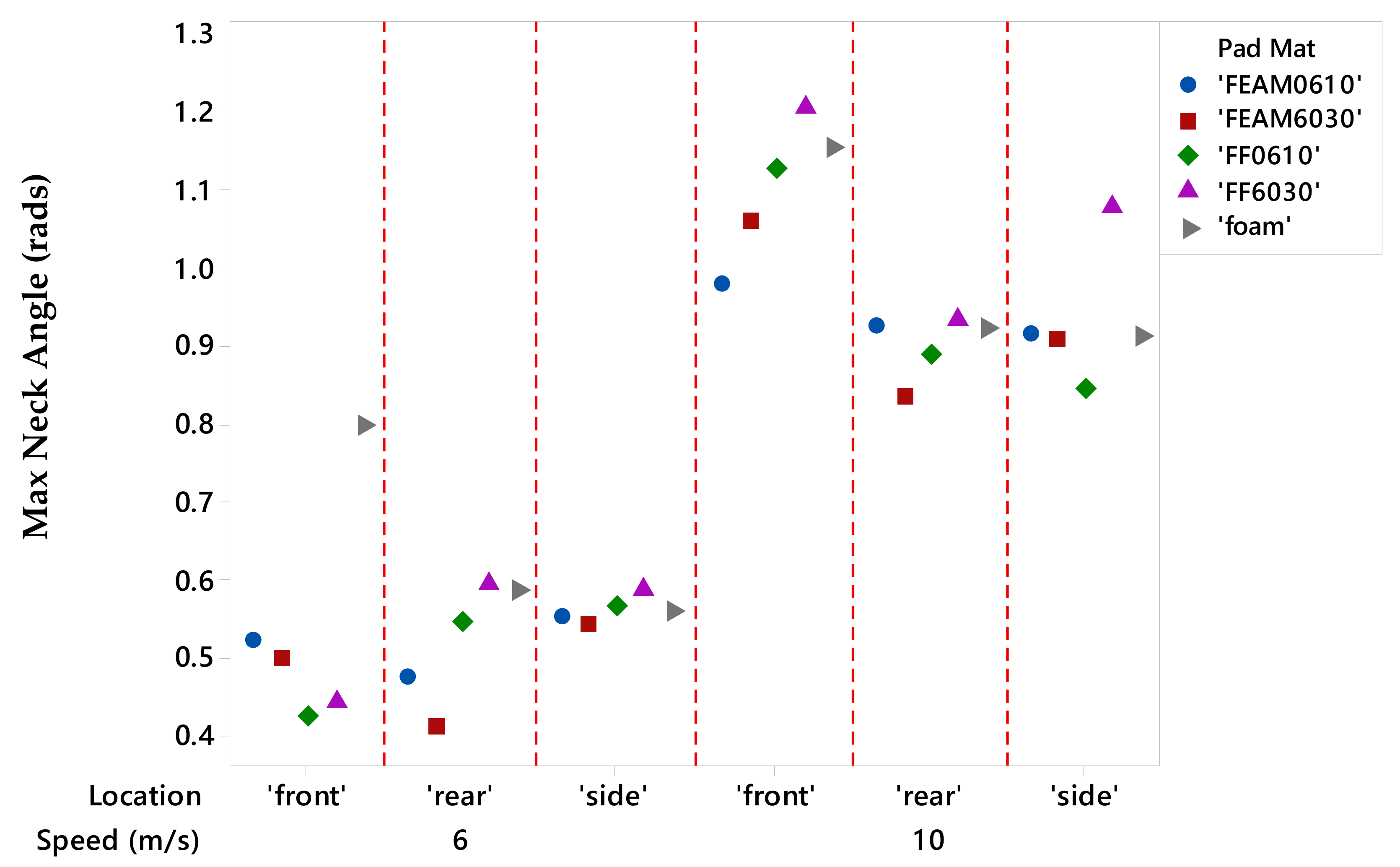
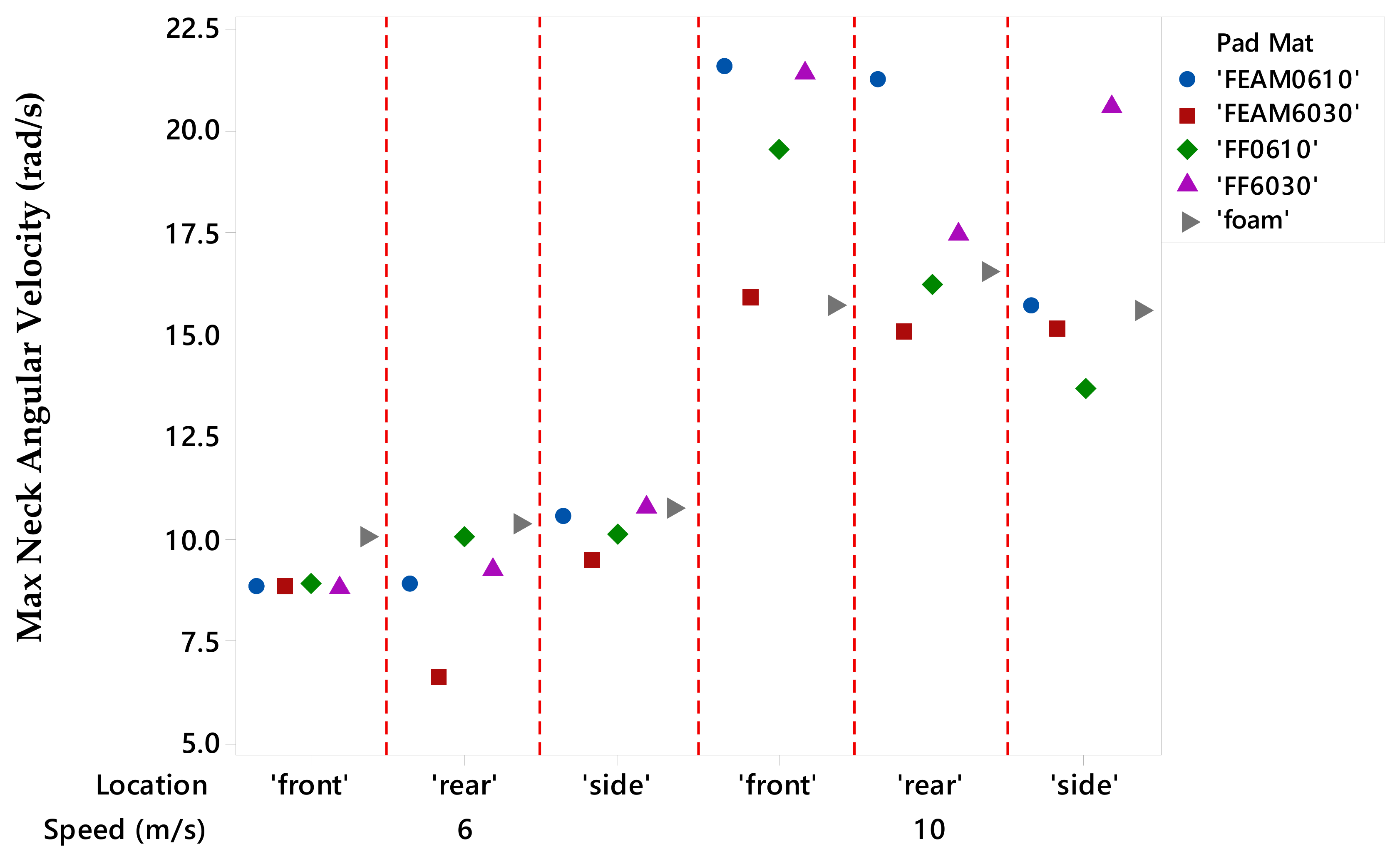
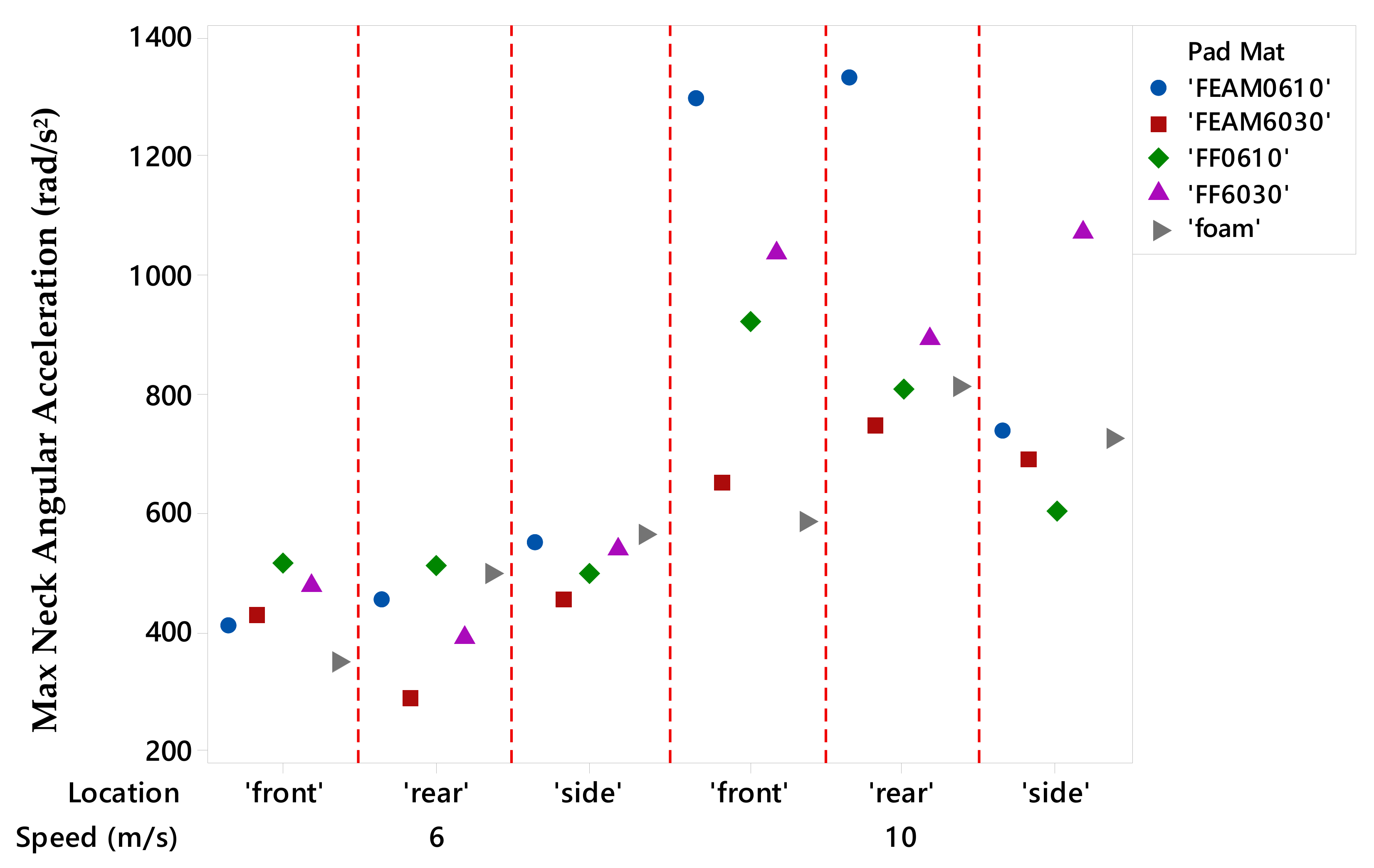
| Padding ID | Area (cm2) | Weight (g) | Thickness (mm) | Thickness Deviation | Density (kg/m3) | Areal Density (kg/m2) | Flock Density (Fibers/mm2) |
|---|---|---|---|---|---|---|---|
| Foam | 692.92 | 221.50 | 25.06 | 3.87 | 127.58 | 3.20 | NA |
| FEAM0610 | 659.82 | 423.40 | 21.59 | 0.33 | 297.16 | 6.42 | 237.44 |
| FEAM6030 | 635.77 | 384.30 | 25.05 | 0.30 | 241.30 | 6.04 | 21.69 |
| FF0610 | 662.95 | 326.35 | 22.07 | 0.87 | 223.03 | 4.92 | 234.44 |
| FF6030 | 654.18 | 345.20 | 22.64 | 0.53 | 233.03 | 5.28 | 19.16 |
| FEAM Type | Flock Mass Fraction | Substrate Mass Fraction | Flock Volume Fraction | Substrate Volume Fraction | Void Fraction |
|---|---|---|---|---|---|
| FEAM0610 | 44.71% | 55.29% | 10.89% | 33.95% | 55.16% |
| FEAM6030 | 59.35% | 40.65% | 13.78% | 23.81% | 62.41% |
| FF0610 | 42.06% | 57.94% | 6.85% | 82.64% | 10.51% |
| FF6030 | 57.65% | 42.35% | 11.23% | 72.30% | 16.48% |
Disclaimer/Publisher’s Note: The statements, opinions and data contained in all publications are solely those of the individual author(s) and contributor(s) and not of MDPI and/or the editor(s). MDPI and/or the editor(s) disclaim responsibility for any injury to people or property resulting from any ideas, methods, instructions or products referred to in the content. |
© 2023 by the authors. Licensee MDPI, Basel, Switzerland. This article is an open access article distributed under the terms and conditions of the Creative Commons Attribution (CC BY) license (https://creativecommons.org/licenses/by/4.0/).
Share and Cite
Correia, J.J.; Chalivendra, V.; Kim, Y. Novel Fiber-Based Padding Materials for Football Helmets. Fibers 2023, 11, 96. https://doi.org/10.3390/fib11110096
Correia JJ, Chalivendra V, Kim Y. Novel Fiber-Based Padding Materials for Football Helmets. Fibers. 2023; 11(11):96. https://doi.org/10.3390/fib11110096
Chicago/Turabian StyleCorreia, Jared J., Vijaya Chalivendra, and Yong Kim. 2023. "Novel Fiber-Based Padding Materials for Football Helmets" Fibers 11, no. 11: 96. https://doi.org/10.3390/fib11110096
APA StyleCorreia, J. J., Chalivendra, V., & Kim, Y. (2023). Novel Fiber-Based Padding Materials for Football Helmets. Fibers, 11(11), 96. https://doi.org/10.3390/fib11110096






